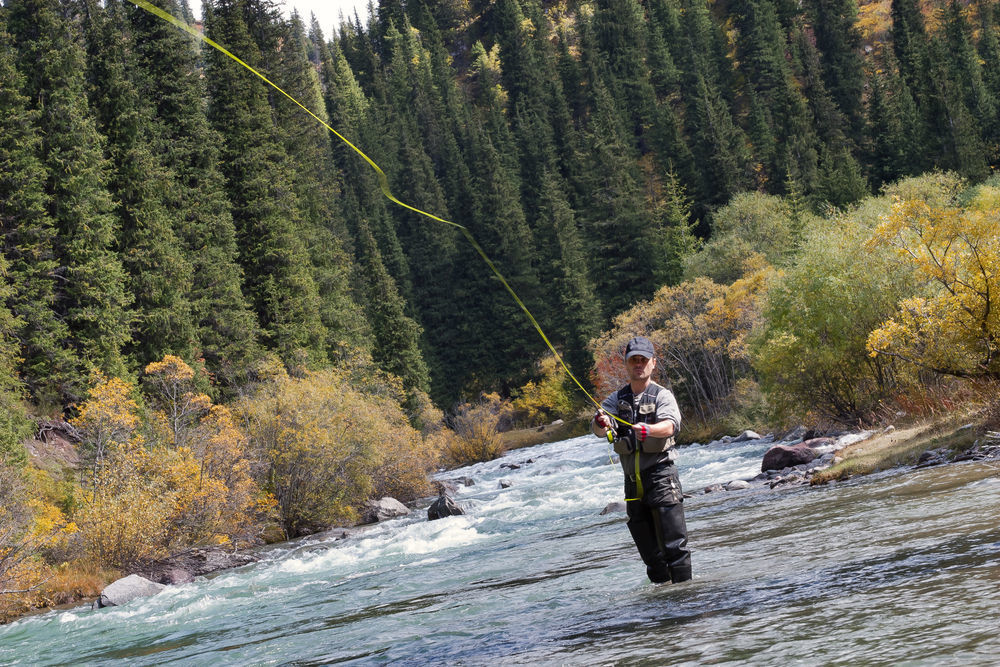What’s one of the coolest ways to fish? Fly fishing! This is a fast-growing subcategory of fishing, providing the challenge while still being gentle for beginners to learn, starting off with casting. It can be quite frustrating trying to fly cast, which is why I want to help you out, so read on as I’ll be teaching fly fishing for beginners in casting!
Fly Fishing For Beginners in Casting
Casting using a fly rod is actually an art form, which is incredibly rewarding but challenging… At first. It will take both patience and practice to master fly-fish casting, though you don’t need the frustration to learn. Here are some basic principles and steps to practice your casting skills!
The Fundamentals
When you cast using regular fishing equipment, you use weighted lures or sinkers. It’s different with fly fishing, as you use lightweight flies made of features or fur. That’s why fly fishing lines are made with thick PVC, which adds heft, so expect the cast to feel like a whip, casting your fly.
The Loop
In any casting stroke, your fly line trails behind your rod’s tip. Once you stop the casting stroke, the energy transfers to your line, unrolling in the direction your rod’s tip was traveling. This forms a loop.
- You have to make sure that the top’s loop unrolls parallel to its bottom.
- The loop is narrow, about 2-3 feet between top to bottom
- It should unroll smoothly and straightly until the end. The entire line and leader should stretch out before it falls in the waters.
Load Your Rod
When creating a cast, you need to “load” the fly rod with energy to release into your fishing line. Think of it like shooting bow and arrow, with the bow bent to store energy to be released when the bow suddenly unbends. With casting a fly rod, the energy load comes from your casting stroke!
Energy Transfer
Energy stored and loaded in fly rods need to transfer smoothly to the line for a successful cast. Each stroke you make needs to have the smooth and building acceleration with the deliberate and sudden stop. This allows your rod to go back to its straight position, still sending out the line to your target.
Read also: Saltwater Fishing In The Rain: Is It A Good Idea?
Types of Casts
There are two different casts to do while fly fishing, such as the:
Overhead Cast
You’ll be using this technique most of the time when fly fishing. This technique can be practiced without water and in large open spaces. You have to learn two parts to this cast:

Fly fishing angler makes cast while standing in water.
Back Cast:
1. Your shoulders should be square and your feet shoulder-width apart, with your grip using four fingers around the rod’s handle. Make sure that your wrist is straight and your elbows are close to the body. Use your shoulder and bicep when doing this cast.
2. Pull 25 feet of fishing line off your reel (it should be straight), feeding it out on the rod’s tip.
3. With one smooth motion, accelerate the rod up and back. Only stop abruptly and deliberately when your rod passes the vertical position.
Forward Cast:
4. With the back cast complete, place the rod forward smoothly. Stop once the rod tip’s high enough for energy to transfer to the line, sending it forward.
5. Lower your rod tip when the line unrolls, which should roll straight until the fly.
Roll Cast
In this casting type, there isn’t an aerial back cast. The line’s drawn backward slowly then hung in slack loops from the rod’s tip. This creates weight required to load your rod for your forward cast. If you do it correctly, the line looks like it unrolls over the surface.
1. You need to practice this cast on water, starting off with 25 feet of line and the rod’s tip pointed at the surface.
2. Draw your rod up and back slowly and smoothly, having enough force to drag the line and leader. Stop the stroke as the rod’s tip is high, past vertical. Your line should be slack, drooping behind your rod’s tip.
3. As the loop is formed, accelerate your rod forward. Stop abruptly and allow the cast to unroll with smoothness.
Wrapping It Up
As fly fishing continues to grow in popularity, it’s time that you get in on the trend and learn this fun sport. As you learn how to fly cast, you can also begin to expand your skills and teach yourself even newer tricks. That way, you can capture all the fish to boast about over the dinner table.
I hope that this article on fly fishing for beginners in casting helped you out. So don’t wait any longer, get invest in quality fly fishing kits and start learning now!
If you have any questions or want to share your tips and experiences in fly fishing, then comment below. Your thoughts are much appreciated.

